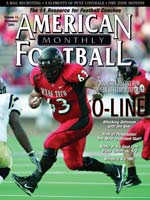AMERICAN FOOTBALL MONTHLY THE #1 RESOURCE FOR FOOTBALL COACHES
Article CategoriesAFM Magazine
|
Fire Zone SchemeTeaching Underneath Coverage Techniques In The Fire Zone Schemeby: Dale L. Sprague © More from this issue Coaching defensive football has taken on a whole new look in recent years with the advent of the “Fire Zone” or what is popularly referred to as the “Zone Blitz.” These schemes, first utilized by several NFL teams in the late 1980s and early 1990s, allow defensive coaches the capability to send five rushers (and in some cases six) while still being able to stay in a zone coverage shell behind the blitz. This scheme first evolved to help defenders take away the offense’s ability to throw the “Hot Read” pass route; a quick inside or short throw that is dependent upon a receiver recognizing the blitz and then replacing the blitzing defender and enabling the quarterback to get the ball off quickly (See Diagrams 1 and 2).  The full article can only be seen by subscribers. The full article can only be seen by subscribers.Subscribe today!
|
|
|||||||
| HOME |
MAGAZINE |
SUBSCRIBE | ONLINE COLUMNISTS | COACHING VIDEOS |
Copyright 2025, AmericanFootballMonthly.com
All Rights Reserved





